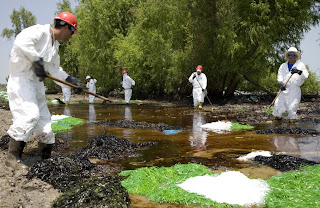


The story line, “Things are almost back to normal on the Mississippi River” isn't so. That is what I’m hearing from the national media and the local media too. Their information source is the Coast Guard, who are carefully controlling access both to the scene of the spill and the information the public is allowed to hear. They mention that the clean up is ongoing, but the illusion that things are greatly improving along the river bank isn’t what I am finding when I explore with my camera in hand. Starting from the shores in the French Quarter going down almost as far as Venice, where the river meets the coast, I have documented a different story.
Interest in the story is limited – The clean up is under control and the river is open. The story is over. Over? Only 77,000 gallons of oil mixed with water have been cleaned up out of the over 400,000 spilled, the barge is still wedged up against the Crescent City Connection. According to the briefing I attended today, the oil still in the tanker will be sucked out by divers, and it will still be days before the remaining vessels are removed. Is it leaking or not?
Each morning the workers find a fresh coat of oil where they left the day before in a much cleaner state.The massive clean up effort underway, described in the media as starting day two after the spill, was an exaggeration. The media were escorted to one spot where workers were cleaning – a couple of hundred workers, a photo op that made it into the newspaper and TV news. Monday the number of clean up crews is 1200; Tuesday it will be up to 2000. 2000 workers to cover 100 miles of coast that each day gets new deposits of oil, some of which is being spread by the boats that are once again moving on the river- some from the tanker which may or may not still be leaking, that can be described as massive. Yet from day two of the spill the media was describing a massive clean up when a couple hundred workers were on the scene A clear exaggeration. The amount of money changing hands post oil spill? Now that is massive. Deciding who gets the contracts and then the clean up companies getting set up, that has in fact taken a week.
On Saturday the coast guard showed the media the boat cleaning process. I saw first hand how boats that were contaminated near the site of the spill, were being cleaned off before being allowed to move upriver. At the briefing this morning it was reported that the first boat let through the oil filled waters wasn’t bad at all. By tomorrow afternoon all of the priority vessels that have been held up will have been sent on their way, and the river traffic will get back to normal by Wednesday. Questions remain- what is a clean vessel? - How much oil is it permissible to track into the Gulf of Mexico or up River? Who decides these amounts? Is the Government making it up as they go along or is there a way to regulate such things? I think a lot of the weights and measures are biased on how long the economy can afford the port being closed.
I photographed clean up crews on Sunday after being told not to-"for my own safety," I wasn't allowed anywhere down the levees. That didn't stop me. A basic rule in photography is to get a close as possible.
The workers told me though they cleaned the site the day before, today they were finding new oil on the surface: just as big a mess as when they first started. The clean up will go on for months. The process is in steps – first remove the oil on the surface (mopping with pompoms and using a boom to collect and stop the flow of the oil) then on the rocks (steam cleaning); then in the soil (dig it up and sift it). . The riverbank will need to be cleaned and re- cleaned until the EPA decides the workers are more disruptive to the eco-system than letting nature finish the job.
Though a small spill in comparison to the Exon Valdez (this spill is one-26th the size), it has other implications on the political landscape. On the 23rd, the day of the spill, McCain was meant to come to town and speak about how great off shore drilling will be for Louisiana and the country. His advisors had the good sense to cancel his visit. How would it look to have McCain taking a first hand look at what an oil spill looks like?
Oil fuels all the main stories of the day- The War, inflation due to the high cost of gas, the destruction of our eco-system: especially in Louisiana where the results of oil companies' works have wreaked havoc on the wetlands: the wet land being the first defense against storm surges such as the one caused by Katrina. Just before the spill congress decided protecting the wetlands wasn’t a local issue but a national one. This spill illustrates the fact that if the port of New Orleans is closed the whole country stands to be affected by the economic impact in the disruption of cargo.
Ironically, the area right at Tulane’s Natural History Museum is one of the most oil covered. This is a museum that Hank Bart (the director) and I have been working to open to the public. Our shared goal has been to educate people about their connection to the natural environment. Though a small spill compared to others in recent times, this one is a reminder that our dependency on oil is something we will have to reckon with, be it in the form of wars for control of resources, or the environmental impact from spills and usage.

















 I first visited Flood Street in November 2006. The irony of a street called Flood Street, was one too rich to pass by.
I first visited Flood Street in November 2006. The irony of a street called Flood Street, was one too rich to pass by. 









 At the end of the day I rode my bike the length of Elysian Fields. From the river to the lake. Blanche DuBois moved into her sister's place on Elysian Field only to be taken off to a mental institution by the end of Tennessee William’s a Street Car Named Desire, “I have always depended on the kindness of strangers", she said to the man who let her leave the premises without having to be put in a straight jacket. Much of Elysian Fields was flooded badly. Signs of Katrina’s wrath start as early as North Rampart and get progressively more intense as you approach the lake.On the ride back, I stopped at a red light where Elysian Fields intersects Humanity Street, took a picture and rode on.
At the end of the day I rode my bike the length of Elysian Fields. From the river to the lake. Blanche DuBois moved into her sister's place on Elysian Field only to be taken off to a mental institution by the end of Tennessee William’s a Street Car Named Desire, “I have always depended on the kindness of strangers", she said to the man who let her leave the premises without having to be put in a straight jacket. Much of Elysian Fields was flooded badly. Signs of Katrina’s wrath start as early as North Rampart and get progressively more intense as you approach the lake.On the ride back, I stopped at a red light where Elysian Fields intersects Humanity Street, took a picture and rode on.





















